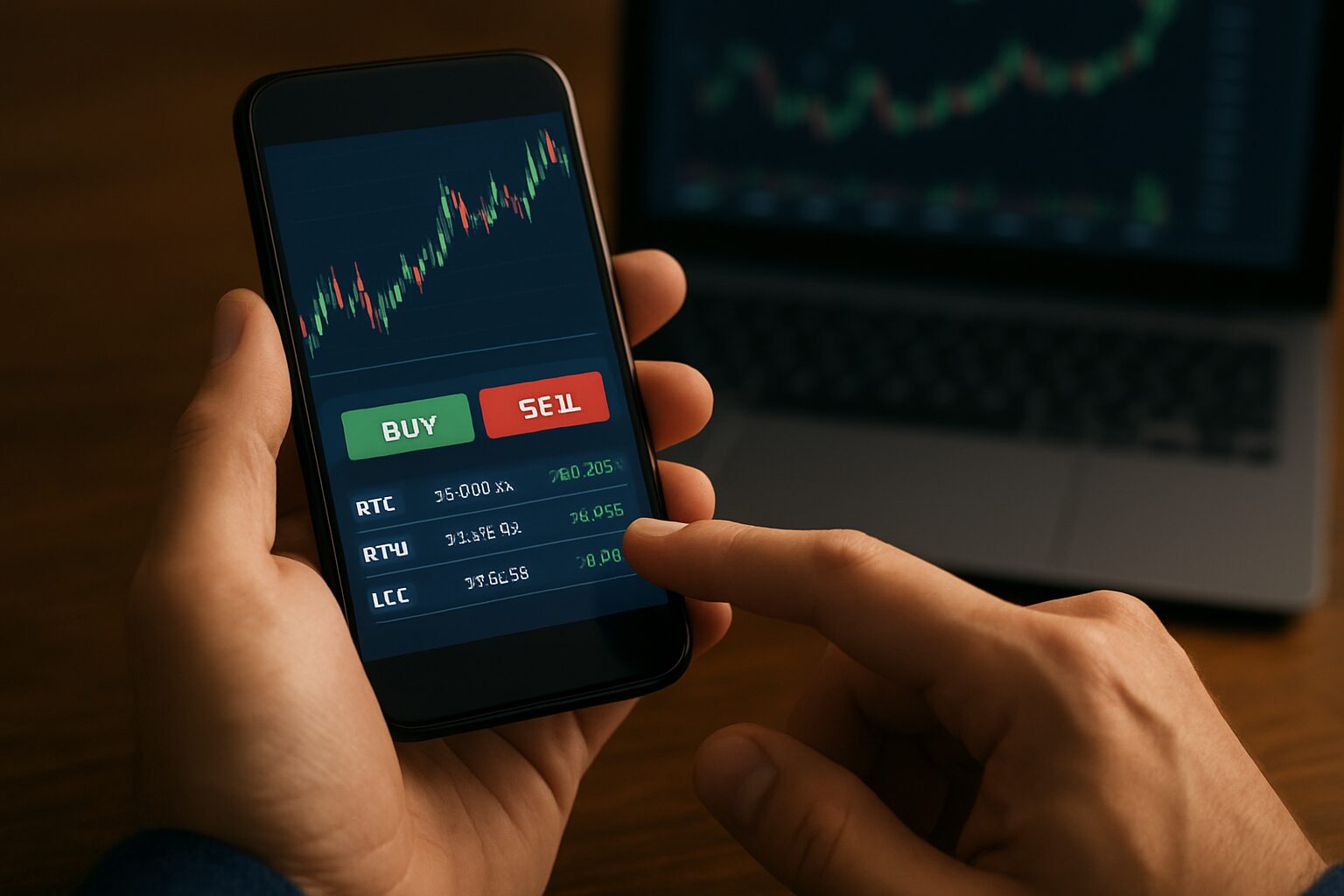Cryptocurrency has completely changed how people think about money and investing. In just over a decade, digital assets like Bitcoin and Ethereum have grown from niche tech projects into global financial instruments worth trillions of dollars. Today, more people are eager to buy, sell, trade crypto as part of their investment journey, exploring new ways to grow wealth in the digital economy.
If you’re new to crypto, learning how to buy, sell, and trade digital assets safely is the first step toward participating in this fast-evolving market. This beginner’s guide will walk you through the basics — from setting up your first exchange account to understanding how crypto trading really works.
What Does “Buy, Sell, Trade” Mean in Crypto?
The crypto world might seem confusing at first, but the terms buy, sell, and trade are simple to understand once broken down:
- Buying crypto means purchasing digital currencies like Bitcoin, Ethereum, or Solana using fiat money (like USD or PHP) or other cryptocurrencies.
- Selling crypto means converting your digital assets back into fiat or stablecoins.
- Trading crypto involves actively buying and selling different coins to profit from market price movements.
Holding (HODLing) vs. Trading
Many beginners choose to HODL — a term that means holding onto crypto for the long term, hoping its value will rise over time. Others prefer trading, which involves short-term strategies to take advantage of price fluctuations.
Both play an important role in the crypto market — HODLers provide stability, while traders add liquidity and keep prices moving
Best Platforms to Buy, Sell, Trade Crypto Safely
If you’re looking to buy, sell, or trade cryptocurrencies safely in the Philippines, here are some of the top platforms to consider in 2025:
- Bybit – Low fees, wide range of coins, ideal for advanced traders.
- Coins.ph – BSP-regulated, PHP deposits/withdrawals, beginner-friendly.
- PDAX – BSP-licensed, secure, local customer support.
- Binance – Global liquidity, many trading pairs, suitable for experienced traders.
- Kraken – Strong security, regulatory compliance, good for cautious traders.
Safety Tips: Use regulated platforms, enable strong security, compare fees, and check customer support.
Recommendation for Beginners: Coins.ph – easy-to-use, local support, fully regulated.
Getting Started: Setting Up for Your First Trade
Before you start buying or selling, you’ll need three main tools:
- A crypto exchange
- A verified account
- A secure wallet
1. Choose a Reliable Crypto Exchange
Choosing where to trade is crucial. You can use a centralized exchange (CEX) like Binance, Coinbase, or Kraken, or a decentralized exchange (DEX) like Uniswap or PancakeSwap.
Centralized Exchanges (CEX):
- Easier to use and beginner-friendly
- Require identity verification (KYC)
- Provide customer support
Decentralized Exchanges (DEX):
- Offer more privacy and control
- No KYC needed
- Require you to connect your crypto wallet
Key factors to consider before signing up:
- Security and reputation
- Trading fees
- Supported cryptocurrencies
- Ease of use
2. Create and Verify Your Account
After selecting an exchange, you’ll need to create an account. Most platforms require KYC verification, which means submitting an ID or selfie to confirm your identity.
Verification helps protect users and prevents fraud — a must for anyone planning to deposit or withdraw money.
3. Set Up a Secure Wallet
Your crypto wallet stores your digital assets. There are two main types:
- Hot Wallets: Online wallets that connect to the internet (like MetaMask or Trust Wallet). Great for quick access but more vulnerable to hacking.
- Cold Wallets: Offline storage like Ledger or Trezor hardware wallets. Best for long-term holders who value security.
Never share your private keys or recovery phrase. Losing them means losing access to your funds permanently.
How to Buy Crypto
Buying crypto for the first time is exciting but can also be confusing. Here’s a simple guide to help you start safely.
Step-by-Step:
- Deposit Funds: Use a bank transfer, credit card, or e-wallet to add money to your exchange account.
- Choose a Cryptocurrency: Start with well-known coins like Bitcoin (BTC), Ethereum (ETH), or Solana (SOL).
- Place a Buy Order: Enter the amount you want to purchase. You can use market orders (buy instantly at the current price) or limit orders (set a specific price).
- Confirm and Store: Once the purchase is complete, transfer your coins to your personal wallet for safety.
Payment Options
- Bank Transfer: Lower fees but slower.
- Credit/Debit Card: Fast but may include higher fees.
- Peer-to-Peer (P2P): Allows direct trading with other users.
Tips for Beginners
- Always double-check wallet addresses before sending funds.
- Avoid buying during market hype — prices often correct afterward.
- Start small and learn as you go.
How to Sell Crypto
Selling your crypto is just as simple as buying it — but timing is everything.
Steps to Sell:
- Select the Coin You Want to Sell
- Choose a Sell Option: You can sell directly to your exchange (market order) or list it at a specific price (limit order).
- Withdraw to Fiat or Stablecoin: Convert your earnings to USDT, USD, or PHP, then transfer to your bank or e-wallet.
Withdrawal Tips
- Always check withdrawal fees.
- Ensure your bank supports crypto-related transactions.
- Double-check wallet and account details before withdrawing.
When Is the Right Time to Sell?
- The right time to sell crypto depends on your goals and market conditions. Consider selling when you’ve reached your target profit, if the asset no longer fits your investment strategy, or to minimize potential losses during a market downturn. Avoid making impulsive decisions based on short-term price swings, and always review your plan before acting.
Remember: Selling too early or too late can impact your profit. Keep learning market trends and analyze your goals before making moves.
How to Trade Crypto Like a Pro (Even as a Beginner)
Trading goes beyond simple buying and selling. It’s about timing, strategy, and analysis.
1. Spot Trading
This is the most straightforward type — you buy and sell crypto at current prices.
Example: Buy 1 BTC at $30,000 and sell at $35,000 for profit.
2. Margin and Futures Trading (Advanced)
These allow you to trade with borrowed funds or speculate on future prices.
While they can amplify profits, they also increase risk. Beginners should proceed carefully or avoid this entirely until they gain more experience.
3. Understanding Trading Pairs
Crypto assets are often traded in pairs, like BTC/USDT or ETH/BTC.
This means you’re trading one currency against another — for instance, buying Bitcoin using USDT.
4. Technical and Fundamental Analysis Basics
Learning to analyze the market helps you make smarter trades:
- RSI (Relative Strength Index): Shows if a coin is overbought or oversold.
- Moving Averages: Help identify long-term trends.
- Volume Indicators: Show trading activity and potential reversals.
Also, stay updated with crypto news. Market sentiment often drives prices.
Safety and Risk Management
Crypto offers high potential returns — but also high risks. Protecting your assets should always come first.
Avoid Common Scams
- Phishing Links: Never click on suspicious links from emails or social media.
- Fake Exchanges or Wallets: Always verify the official website.
- Rug Pulls: Be cautious of new tokens promising unrealistic returns.
Enable Security Features
- Turn on two-factor authentication (2FA).
- Use withdrawal whitelists to limit where funds can go.
- Regularly update passwords and store backups safely.
Smart Investing Habits
- Diversify your portfolio across different coins.
- Never invest more than you can afford to lose.
- Use stop-loss orders to limit losses on trades.
Tools and Resources for Crypto Beginners
Make your crypto journey easier with the right tools:
Portfolio Trackers
- CoinMarketCap – for real-time prices and rankings.
- CoinGecko – for detailed analytics and token data.
Learning Platforms
- The Coin Republic – for crypto news and insights.
- Binance Academy – free educational content on trading and blockchain.
Community Support
Join Reddit, Discord, or Telegram crypto communities to learn from others and stay updated on market trends.
The Future of Buy, Sell, trade Crypto
The crypto industry is still evolving — and the next decade will likely bring even bigger changes.
Emerging Trends
- DeFi (Decentralized Finance): Users earn yield or borrow without banks.
- NFTs: Still growing beyond art — now used for real estate, games, and digital identity.
- Tokenized Assets: Real-world assets like gold or property represented as crypto tokens.
AI and Automation
Artificial intelligence tools are making crypto trading smarter by predicting price movements and managing portfolios automatically.
Global Adoption
More governments are developing crypto regulations and digital currencies (CBDCs), pushing crypto further into the mainstream
Conclusion
Learning to buy, sell, and trade crypto is more than just an investment opportunity — it’s your entry into a new financial system.
Start small, stay consistent, and always keep learning. The crypto market rewards patience and understanding, not panic or hype.
FAQs (Frequently Asked Questions)
1. What is the best platform to buy and sell crypto?
Popular and trusted platforms include Binance, Coinbase, and Kraken for beginners. Always check reviews and supported payment methods in your country.
2. How much do I need to start trading?
You can start with as little as $10 to $50. Most exchanges allow small trades, letting you learn without big risks.
3. Can I lose money trading crypto?
Yes. Crypto prices are highly volatile. Always manage your risks and invest only what you can afford to lose.
4. What is the difference between trading and investing in crypto?
Trading focuses on short-term profits from price changes. Investing (or HODLing) focuses on long-term growth.
5. Do I need a wallet to trade crypto?
Most exchanges provide built-in wallets, but using your own crypto wallet (like MetaMask or Ledger) gives you more control and security.
6. What is the safest way to store my crypto?
Use a hardware wallet or a cold wallet for long-term storage. Avoid keeping large amounts of crypto on exchanges.
7. How do I avoid scams when buying crypto?
Always use verified exchanges, enable 2FA, and never click on suspicious links or share your private keys.
8. Is it possible to trade crypto 24/7?
Yes! The crypto market operates 24/7, unlike traditional stock markets that close on weekends and holidays.
9. What are stablecoins and why are they important?
Stablecoins like USDT or USDC are pegged to fiat currencies. They help traders protect profits during market volatility.
10. Are there fees when buying or selling crypto?
Yes. Exchanges charge transaction fees, which vary per platform. Always check the fee structure before trading.
11. Can I trade crypto on my phone?
Absolutely. Most major exchanges have mobile apps, allowing you to buy, sell, and track your portfolio anytime.
12. Is crypto trading legal in every country?
Crypto legality varies. Some countries fully support it, while others impose restrictions. Always check your local regulations.
13. How do I know when to buy or sell crypto?
Use technical indicators and stay updated with market news. Many traders also follow support and resistance levels to time entries and exits.
14. Can I earn passive income with crypto?
Yes. You can stake, lend, or join DeFi platforms to earn rewards on your holdings.
15. What are trading pairs in crypto?
Trading pairs like BTC/USDT or ETH/BTC show how one currency is valued against another, helping traders exchange assets easily.
Disclaimer
This article is for educational purposes only and should not be considered financial advice. Cryptocurrency investments carry risks, including potential loss of capital. Always do your own research or consult with a financial advisor before making investment decisions.



